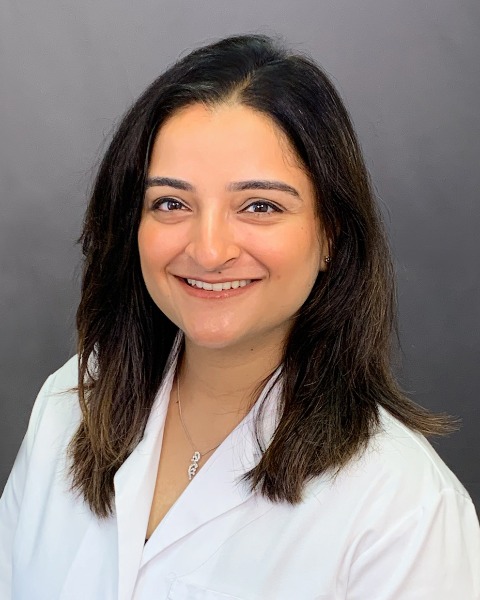Monday Poster Session
Category: IBD
P3414 - Fistulizing Crohn's Disease in Adulthood Following Neonatal Necrotizing Enterocolitis and Subtotal Colectomy: A Case Report and Pathophysiologic Link
Monday, October 27, 2025
10:30 AM - 4:00 PM PDT
Location: Exhibit Hall

Shruti Khurana, MD (she/her/hers)
SHRUTI KHURANA, MD
Burlington, VT
Presenting Author(s)
Ajwah Qasim, MD1, Shruti Khurana, MD2
1Crestwood Medical Center, Hunstville, AL; 2SHRUTI KHURANA, MD, Burlington, VT
Introduction: We report a rare case of de novo Crohn's disease (CD) in a 42-year-old woman with a history of prematurity and neonatal necrotizing enterocolitis (NEC), managed with subtotal colectomy and ileocolonic anastomosis.
Case Description/
Methods: A 42-year-old woman with a history of NEC treated with subtotal colectomy and ileocolonic anastomosis at day 3 of life, presented with hematochezia, perianal pain, and a palpable perianal mass. A magnetic resonance (MR) anal fistula protocol revealed complex perianal fistulae with cellulitic changes and rectal fistulous tracts. Examination under anesthesia confirmed bilateral transsphincteric fistulae, and two setons were placed.
Sigmoidoscopy demonstrated inflammation and ulceration in the neoterminal ileum proximal to the ileosigmoid anastomosis. Histopathology showed focal active chronic ileitis with mild architectural distortion. Fecal calprotectin was 675 μg/g (normal range < 50 μg/g). MR enterography noted small bowel inflammation in the terminal ileum with no strictures identified. Based on clinical, endoscopic, radiologic, and histologic findings, she was diagnosed with de novo fistulizing Crohn’s disease.
The patient was initiated on combination therapy with infliximab and weight-based azathioprine following confirmation of normal TPMT activity. Despite ongoing biologic therapy and antibiotics, she continued to experience fatigue, drainage from fistulae, and new-onset IBD-related arthropathy consistent with extraintestinal IBD manifestation.
Discussion: This case illustrates the diagnostic challenges of identifying CD in patients with prior extensive intestinal surgery. It also raises the possibility of a pathophysiologic continuum between NEC and IBD. There is a hypothesized interplay of shared mechanisms between NEC and CD, including dysregulated innate immune responses, genetic predispositions, mucosal barrier dysfunction, and microbiota alterations.
Recognition of this potential progression is critical, especially in patients with remote gastrointestinal injury and persistent or atypical GI symptoms in adulthood. Further research is needed to clarify whether NEC may predispose to IBD later in life and to guide surveillance strategies in this growing survivor population.
The unusual presentation highlights the need for a high index of suspicion and multidisciplinary care. Management remains difficult, with lower rates of fistula healing despite biologic and immunomodulator therapy.
Disclosures:
Ajwah Qasim indicated no relevant financial relationships.
Shruti Khurana indicated no relevant financial relationships.
Ajwah Qasim, MD1, Shruti Khurana, MD2. P3414 - Fistulizing Crohn's Disease in Adulthood Following Neonatal Necrotizing Enterocolitis and Subtotal Colectomy: A Case Report and Pathophysiologic Link, ACG 2025 Annual Scientific Meeting Abstracts. Phoenix, AZ: American College of Gastroenterology.
1Crestwood Medical Center, Hunstville, AL; 2SHRUTI KHURANA, MD, Burlington, VT
Introduction: We report a rare case of de novo Crohn's disease (CD) in a 42-year-old woman with a history of prematurity and neonatal necrotizing enterocolitis (NEC), managed with subtotal colectomy and ileocolonic anastomosis.
Case Description/
Methods: A 42-year-old woman with a history of NEC treated with subtotal colectomy and ileocolonic anastomosis at day 3 of life, presented with hematochezia, perianal pain, and a palpable perianal mass. A magnetic resonance (MR) anal fistula protocol revealed complex perianal fistulae with cellulitic changes and rectal fistulous tracts. Examination under anesthesia confirmed bilateral transsphincteric fistulae, and two setons were placed.
Sigmoidoscopy demonstrated inflammation and ulceration in the neoterminal ileum proximal to the ileosigmoid anastomosis. Histopathology showed focal active chronic ileitis with mild architectural distortion. Fecal calprotectin was 675 μg/g (normal range < 50 μg/g). MR enterography noted small bowel inflammation in the terminal ileum with no strictures identified. Based on clinical, endoscopic, radiologic, and histologic findings, she was diagnosed with de novo fistulizing Crohn’s disease.
The patient was initiated on combination therapy with infliximab and weight-based azathioprine following confirmation of normal TPMT activity. Despite ongoing biologic therapy and antibiotics, she continued to experience fatigue, drainage from fistulae, and new-onset IBD-related arthropathy consistent with extraintestinal IBD manifestation.
Discussion: This case illustrates the diagnostic challenges of identifying CD in patients with prior extensive intestinal surgery. It also raises the possibility of a pathophysiologic continuum between NEC and IBD. There is a hypothesized interplay of shared mechanisms between NEC and CD, including dysregulated innate immune responses, genetic predispositions, mucosal barrier dysfunction, and microbiota alterations.
Recognition of this potential progression is critical, especially in patients with remote gastrointestinal injury and persistent or atypical GI symptoms in adulthood. Further research is needed to clarify whether NEC may predispose to IBD later in life and to guide surveillance strategies in this growing survivor population.
The unusual presentation highlights the need for a high index of suspicion and multidisciplinary care. Management remains difficult, with lower rates of fistula healing despite biologic and immunomodulator therapy.
Disclosures:
Ajwah Qasim indicated no relevant financial relationships.
Shruti Khurana indicated no relevant financial relationships.
Ajwah Qasim, MD1, Shruti Khurana, MD2. P3414 - Fistulizing Crohn's Disease in Adulthood Following Neonatal Necrotizing Enterocolitis and Subtotal Colectomy: A Case Report and Pathophysiologic Link, ACG 2025 Annual Scientific Meeting Abstracts. Phoenix, AZ: American College of Gastroenterology.
